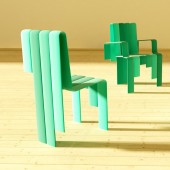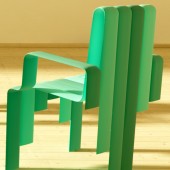
| THE AWARD |
| CATEGORIES |
| REGISTRATION |
| SUBMIT YOUR WORK |
| ENTRY INSTRUCTIONS |
| TERMS & CONDITIONS |
| PUBLICATIONS |
| DATES & FEES |
| METHODOLOGY |
| CONTACT |
| WINNERS |
| PRESS ROOM |
| GET INVOLVED |
| DESIGN PRIZE |
| DESIGN STORE |
| THE AWARD | JURY | CATEGORIES | REGISTRATION | PRESS | WINNERS | PUBLICATIONS | ENTRY INSTRUCTIONS |
Waterfall Chair and Armchair by Jorge Prieto |
Home > Winners > Design #26536 >Interview |
 |
|
FS: What is the main principle, idea and inspiration behind your design?
JP: Recycling and sustainability are the keys of this design.
FS: What has been your main focus in designing this work? Especially what did you want to achieve?
JP: After seeing how much waste we produce on the production of any other design, I decided there had to be a way to reuse all that waste and turn into a whole new product
FS: What are your future plans for this award winning design?
JP: Selling the idea would be nice if possible.
FS: How long did it take you to design this particular concept?
JP: In a month it was already finished, the process went really smooth and quick.
FS: Why did you design this particular concept? Was this design commissioned or did you decide to pursuit an inspiration?
JP: I was working on a design proposal for the furniture company I was working for and, even though it was not their style, I liked the idea and continued developing it on my own.
FS: Is your design being produced or used by another company, or do you plan to sell or lease the production rights or do you intent to produce your work yourself?
JP: No, not yet but I will sell the production rights to any interested in it. Producing it on my own may be a bit too expensive.
FS: What made you design this particular type of work?
JP: I always try to achieve the best sustainable solution in each one of my designs and in this case I reached it by recycling used plywood sheets.
FS: Where there any other designs and/or designers that helped the influence the design of your work?
JP: The Designer in Chief who I was working for at the Mobilfresno furniture company at Yecla supervised this project while working with them.
FS: Who is the target customer for his design?
JP: The production of this chair is really cheap once made the molds and there aren't really material costs as you are reusing them, which makes the design affordable for anyone.
FS: What sets this design apart from other similar or resembling concepts?
JP: Most of the furniture we have today is created in mass production, which means they are all the same. That is not the case of the Waterfall chair where each one is different from the rest, even if you decide to upholster it.
FS: How did you come up with the name for this design? What does it mean?
JP: The look of the planks running over the structure with different lengths resemble of a Waterfall.
FS: Which design tools did you use when you were working on this project?
JP: AutoCAD, 3D Studio, Rhinoceros and Keynote.
FS: What is the most unique aspect of your design?
JP: Each one of the chairs and armchairs is unique itself as the material on each one of the bent planks has a different length, texture and color.
FS: Who did you collaborate with for this design? Did you work with people with technical / specialized skills?
JP: Designers and wood manufacturers at the furniture fabric I was working on.
FS: What is the role of technology in this particular design?
JP: The process of bending plywood sheets is quite simple when you have the molds, so the role of technology in this case is small.
FS: Is your design influenced by data or analytical research in any way? What kind of research did you conduct for making this design?
JP: I made a research on the actual amount of waste produced every year in the production of a simple plywood product and looked how to create a product even cheaper from there.
FS: What are some of the challenges you faced during the design/realization of your concept?
JP: I had to make sure the width and length of the planks was more than enough after they were bent so it didn't compromise the stability of the chair.
FS: How did you decide to submit your design to an international design competition?
JP: I think the design would have possibilities and I decided to try.
FS: What did you learn or how did you improve yourself during the designing of this work?
JP: There were many different sustainable processes to create a new eco-friendly design, but this was the most reliable for the project.
FS: Thank you for providing us with this opportunity to interview you.
A' Design Award and Competitions grants rights to press members and bloggers to use parts of this interview. This interview is provided as it is; DesignPRWire and A' Design Award and Competitions cannot be held responsible for the answers given by participating designers.
| SOCIAL |
| + Add to Likes / Favorites | Send to My Email | Comment | View Press-Release |





